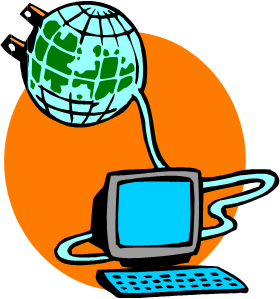 The Internet is a global system of interconnected computer networks that use the standard Internet Protocol Suite to serve billions of users worldwide. It is a network of networks that consists of millions of private and public, academic, business, and government networks of local to global scope that are linked by a broad array of electronic and optical networking technologies. The Internet carries a vast array of information resources and services, most notably the inter-linked hypertext documents of the World Wide Weband the infrastructure to support electronic mail.
The Internet is a global system of interconnected computer networks that use the standard Internet Protocol Suite to serve billions of users worldwide. It is a network of networks that consists of millions of private and public, academic, business, and government networks of local to global scope that are linked by a broad array of electronic and optical networking technologies. The Internet carries a vast array of information resources and services, most notably the inter-linked hypertext documents of the World Wide Weband the infrastructure to support electronic mail.Most traditional communications media, such as telephone and television services, are reshaped or redefined using the technologies of the Internet, giving rise to services such as Voice over Internet Protocol and IPTV. Newspaper publishing has been reshaped into Web sites, blogging, and web feeds. The Internet has enabled or accelerated the creation of new forms of human interactions through instant messaging, Internet forums, and social networking sites.
The origins of the Internet reach back to the 1960s when the United States funded research projects of its military agencies to build robust, fault-tolerant and distributed computer networks. This research and a period of civilian funding of a new U.S. backbone by the National Science Foundation spawned worldwide participation in the development of new networking technologies and led to the commercialization of an international network in the mid 1990s, and resulted in the following popularization of countless applications in virtually every aspect of modern human life. As of 2009, an estimated quarter of Earth's population uses the services of the Internet. 
The Internet has no centralized governance in either technological implementation or policies for access and usage; each constituent network sets its own standards. Only the overreaching definitions of the two principal name spaces in the Internet, the Internet Protocol address space and the Domain Name System, are directed by a maintainer organization, the Internet Corporation for Assigned Names and Numbers . The technical underpinning and standardization of the core protocols is an activity of the Internet Engineering Task Force , a non-profit organization of loosely-affiliated international participants that anyone may associate with by contributing technical expertise.

The Internet has no centralized governance in either technological implementation or policies for access and usage; each constituent network sets its own standards. Only the overreaching definitions of the two principal name spaces in the Internet, the Internet Protocol address space and the Domain Name System, are directed by a maintainer organization, the Internet Corporation for Assigned Names and Numbers . The technical underpinning and standardization of the core protocols is an activity of the Internet Engineering Task Force , a non-profit organization of loosely-affiliated international participants that anyone may associate with by contributing technical expertise.

No comments:
Post a Comment